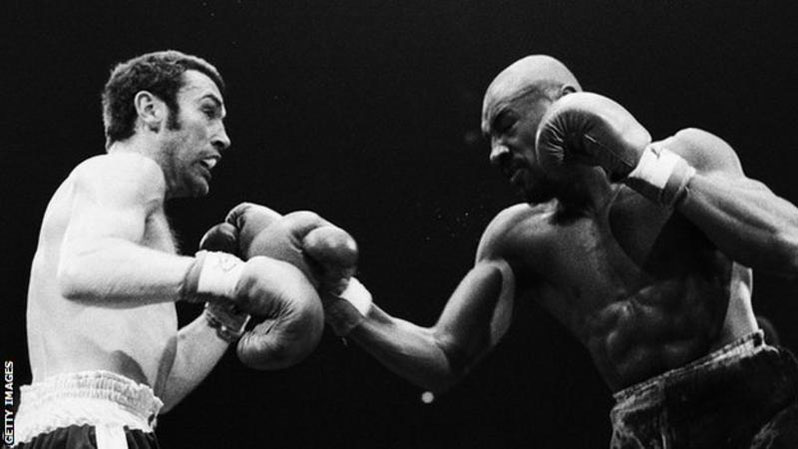By Mike Costello, BBC boxing correspondent
IT is hard to over-estimate the impact of ‘Marvellous’ Marvin Hagler in boxing history.
When he became world middleweight champion in September 1980, the career of Muhammad Ali was fizzling out and concerns were widespread as to who would replace ‘The Greatest’ as boxing’s flagbearer in terms of global appeal.
Enter the Four Kings
Hagler was joined by Sugar Ray Leonard, Tommy Hearns and Roberto Duran in creating a decade of memories, with no need to listen to ballads about the best never fighting the best.
The first of the quartet to die, Hagler was revered as a ‘blue-collar’ champion and the fighters’ fighter. From the greats to the ordinary, the reaction online and elsewhere has amounted to a tidal wave of shock, respect and condolence.
He was unconventional as a right-handed southpaw. Generally, but not always, fighters lead with their weaker hand, allowing for an increase in power driven through the body from the feet up into the (usually stronger) back-hand.
He would switch freely from southpaw to orthodox, seemingly carrying equal power in each hand; he was effective in attacking to the body as well as the head, blessed with sweet timing and a rock-hard chin.

At times, even against the very best, he seemed to own more of the ring than his opponent.
Alan Minter, the man Hagler dethroned to take the undisputed middleweight crown on a volatile night at Wembley Arena four decades ago, once told me in an interview that he had watched Hagler hit a punchbag in training and noticed how the American turned his fist at the point of contact, generating a sound close to a screech which stood out from the clanging of the chains.
In September 1980, Hagler fought Britain’s Alan Minter at Wembley Stadium to claim his first world titles, winning the WBA and WBC belts
In September 1980, Hagler fought Britain’s Alan Minter at Wembley Stadium to claim his first world titles, winning the WBA and WBC belts
On the night, Minter succumbed in three rounds, his face slashed as though Hagler’s gloves were adorned with razor blades. Another Briton, Tony Sibson, suffered a similarly bloody defeat in Hagler’s sixth title defence in 1983. Sibson lasted six rounds but caught Hagler on a night when the champion chose to display the bulk of his repertoire, the accuracy and delivery of the punches all part of a masterclass in ring generalship.
Of Hagler’s 13 World title defences, only two went the distance. His three-round explosion against Hearns in April 1985 takes some shifting as the choice of fight to take to a desert island. The first round might never be equalled for ferocity.
The points reverse against Sugar Ray Leonard at the same Caesars Palace Arena in Las Vegas two years later ranks as one of the most hotly-contested decisions of all-time. Hagler finished two rounds up on one card, Leonard the winner by two rounds and eight rounds on the others. I scored it 116-112 (eight rounds to four) in favour of Leonard – those who disagree would fill many a stadium.
In Leonard’s camp, the great trainer Angelo Dundee had noticed “a Hagler flaw” and revealed the thinking in his autobiography ‘I Only Talk Winning’: “He (Hagler) needed two steps to get off with his punches.” Leonard read so much of what Hagler intended to throw. Some argue that Leonard created an illusion of control based on dancing; others that Hagler did not deserve reward for connecting only with thin air.
I watched the fight overnight at the Royal Festival Hall in London, a special experience in the pre-satellite/cable-TV days in the UK and an indication of the magnitude of the event.
The nights weren’t always so glossy for Hagler. He engaged in scraps at The Spectrum in Philadelphia which became known as the ‘Philly Wars’, losing on points to Bobby ‘Boogaloo’ Watts and Willie ‘The Worm’ Monroe two months apart in 1976. He would avenge the setbacks before lifting the world title and the value of those experiences proved to be important blocks in the building of the colossus.
In his inestimable chronicle ‘Four Kings’, the American writer George Kimball recounted the story of why Hagler chose to turn professional after winning the national amateur championship in Boston in 1973, rather than wait for a tilt at Olympic Games glory in Montreal three years later. “You can’t take a trophy and turn it into a bag of groceries,” was Hagler’s fuss-free philosophy.
Kimball notes how Hagler earned $40 (now around $240) for the pro debut. The everyman story endeared him to so many and has prompted such an outpouring of tributes.
We could wish for the fantasy fights: would Hagler have beaten Sugar Ray Robinson in the 50s, Carlos Monzon in the 70s or Canelo Alvarez today?
But we shouldn’t be greedy. He left us with so much to cherish.




.png)









